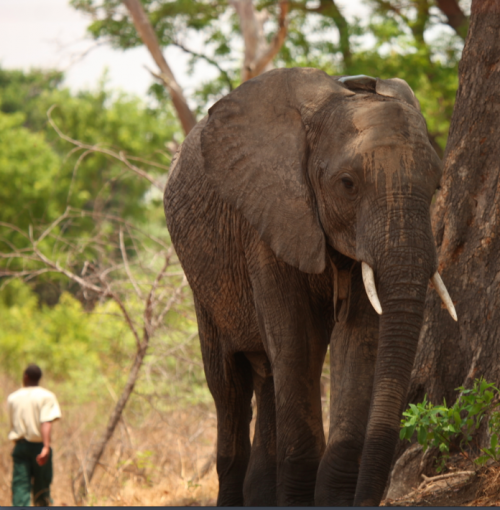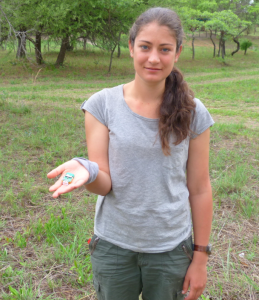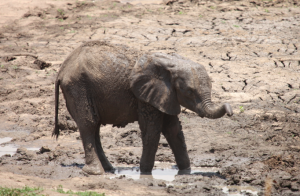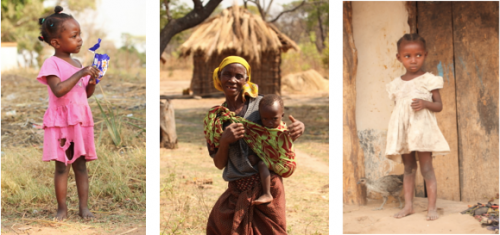
Sarah Eccleston – Cisco UK&I’s Director of EN and the Internet of Things – is in Zambia spending a month living in an elephant orphanage, where she hopes to connect elephants to the internet. Follow Sarah to Africa and back on this blog to find out why, how and whether it works.
I’ve never worked so hard on vacation. In fact, I am not sure I have ever worked so hard at work.
Each afternoon, when the wildlife activity is high, we complete a transect. A transect is where another researcher and myself stand on the back of the truck along the same 40km perimeter every day in order to observe, photograph and identify every herd of ele’s we see. Back home in London, a good day at work is when I get through all my emails and someone brings in free cake. Here, a good day is when we don’t get charged by a 2500kg elephant.
We spend the following morning, starting at 7am, in the office entering the data onto the computer and trying to identify the elephants we observed against a database of previously-seen ele’s.
The elephant equivalent of a fingerprint is the pattern of their ears, so by noting the veins, nicks and holes in the ears, plus the tusks, we identify the herd. This is a lengthy process of entering data and photos of each elephant taken from the front, left and right into a database and then studying the database of elephant photographs to (hopefully) match each ele.
For example, here is an elephant we observed this week:-

And here is one in the database – named F0023 – that I thought could be the same elephant (same ear veins, same missing tusk):-

But no. It isn’t. So you can see how tricky and prone to human error this is.
Technology Need 1: If elephants were connected to the internet, this process would be redundant because we would know in real time where ALL the elephants were, and their identities, and even their heartbeat.
Big data analytics engines currently available – such as SAP’s HANA – can compute and provide insight from a billion items of data in 1.2 seconds. So you can see how much more efficient the data analysis would then also be, rather than humans matching photos. The expectation is that these analytics engines would then predict the movements and behaviours of elephants, enabling us to better protect them. It would also analyse poaching data and even be able to better predict where poaching would next occur (in exactly the same way we will be using big data to predict, and this help us to prevent, crime and terrorism).
Technology Need 2: In the meantime, could someone make an app for this elephant ear recognition? Or could Cisco facial recognition cameras do this job?
Action on Return to the UK: Arrange a hackathon to get an “ear recognition program” developed?
Why is this transect process important? Because when an orphan is ready for re-introduction back into the wild, we need to be sure of it’s new environment and even know a herd it may integrate with.
Which brings me to Chodoba:

Chodoba was brought to this GRI orphanage in Zambia when he was just two years old, after his mother was poached. At the time, he had been alone for so long that he suffered many diseases and injuries, causing most people to think he would surely die. But the team here at GRI tried everything they could to save him, and sure enough, he is now 10 years old. The elephant keepers have rehabilitated him for 8 years and he is ready for independence back in the wild.
Chodoba was not unlike the average human teenager at telling the keepers this – several months ago he started to be “naughty”, break through the fencing, refused to come back to the boma when he was supposed to, etc. So the keepers knew it was time to let Chodoba go.
But he doesn’t just get released – it’s a gradual process of easing him back over several months. For example, At 6pm each day, Chodoba has learned that the orphans return from their walk to the boma and then are kept safely in their beds each night. So he has a daily choice – to come in with the others, or stay out alone. Increasingly, he has chosen to stay out alone. But he hasn’t yet left the area completely – he stays in the vicinity, becoming increasingly more brave and venturing further.
In fact, on Sunday, he was right outside my tent.

All of this makes him the perfect elephant to connect to the internet. Because then each night when he stays out of the boma, we can see where he is going.
Technology Challenge 1:
The first problem you encounter when trying to connect African elephants to the internet, is what internet?? It is impossible for me to convey how remote and vast this landscape is. In the west we talk of the internet as a human right and a utility, but here in Africa there are no utilities… there is no water, gas or electricity. Which makes the idea of having internet access seem crazy.
But who said there is anything wrong with crazy?
Organisations like Sigfox will perhaps provide one answer. They provide a means of lower bandwidth and lower cost connectivity, which is not suitable for telephone or video communication but provide enough bandwidth to connect “things”. This is actually ideal – because it means we are not building an internet which would give better connectivity and collaboration capabilities to the poachers, but we are building an internet good enough to connect “things” to the internet, like elephants, trees, trip cameras and park borders.
In the meantime, another method is satellite and a Cisco WLAN… so Thursday morning I set up the Inmarsat BGAN and gave the Cisco 819 router a run for it’s money. I think the picture below pretty much proves that the Ruggedised 819 router really is rugged.

Within 9 minutes, I had a 100Mb internet connection and a WLAN in the African bush. Thank-you Cisco and Inmarsat.
Technology Challenge 2:
Next up – how do you get a sensor on an elephant? Darting 600,000 African elephants is not feasible.
However, that could be reduced by putting a sensor only on the matriarch of the herd. All herds here are led by a matriarch and the other elephants are never far from her. In fact, a female elephant will die before leaving her calf (which makes it all the more tragic when a mother is shot for her ivory and the calf is left to die… the calf often doesn’t leave the slaughtered mother either, and tries to “nudge” her to get up). So when you know where the matriarch is, you know where the herd is.
However, the point of connecting elephants is not just for location – it is also for sensory information like her heartbeat, stress levels, etc… so that when her heartbeat stops, the armed scouts can immediately go to the area to catch the poachers if she has been shot. But…quite possibly, it won’t be the matriarch that has been shot, it may be one of the other females with tusks.
Also, often it is a bull who is slaughtered. After all, his tusks are usually longer. But an adult bull elephant does not live with a herd of females and calves, he lives mostly alone. So all the males would need to be connected too.
So that still leaves us with the dilemma of how do we get a sensor on an elephant and this is one challenge I suspect will ease as sensor technology develops. Spray-on sensors are being developed for example. Like most things computer-related, over time things get smaller and smaller (remember how big your first mobile phone was?) and the same will happen with sensors. So on returning to the UK, this will be a key focus area… looking for the right kind of sensor.
In the meantime, I was kindly loaned a sensor by ZSL, which we have attached to Chodoba on his collar.

Technology Challenge 3:
How do you get the sensor to STAY on the elephant?
This is tricky. Watching herd behaviour provides a lot of input to why this will be a challenge… first, watching elephants here who have an injury, it’s noticeable that the other elephants sense, stroke and smell the injury with their tusks. They will do exactly the same if a sensor is placed on an ele.
Second, the elephant loves to roll in the mud. This is partly play, it’s also cooling for them, and also the mud acts as a sunscreen. But for sure, one roll in the mud and the sensor will be lost.
I have no answer for this, so all ideas welcome.

Technology Challenge 4:
A challenge as big as all of the above, which I hadn’t realized was as significant until I was here in person, is this… If we build an internet – perhaps something like sigfox – to connect these sensors, then how do we stop it all from getting stolen?
Africans are ingenious – they can make something out of what we in the west would call nothing. Even just a roll of wire, or a sheet of metal, therefore gets stolen, and no doubt appears on a home-made appliance of some sort. Wire fencing gets stolen as quickly as it gets installed – so realistically, how long would an internet access point last?!
One idea is to locate the armed scouts & rangers and these internet PoPs (points of presence) together, to protect them from theft.
So, for now, the sensor from ZSL is connected on the elephant. When I return to the UK and therefore have both electricity and 50Mb of bandwidth even when it’s cloudy (it’s true – you really don’t know what you’ve got till it’s gone), I will be able to upload the high-bandwidth maps onto this blog to show a pictorial view of Chodoba’s journey into the wild each night.
What remains for me to consider is not just whether we can connect an elephant to the internet, but also whether we should. First, I envisage a scenario where a poacher will be able to locate the elephant and kill it BECAUSE it is on the internet. Without doubt, Cisco we can secure the Internet of Things to ensure data and location information can’t be hacked. But this is Africa, where education levels are lower, poverty levels are much, much higher and the daily challenge of finding enough food and water for your family is a bigger concern that ensuring the latest security patches have been applied.

So, how can I be 100% confident that the full security solution would be deployed and kept up to date? We therefore have to be responsible and ensure we only implement a solution that is guaranteed to be secure and is a tool to fight the poachers, not to aid them.
Also, there is an ethical question. While living here in the African bush, one gets a compelling sense of how much these animals deserve to live free in the wild, as nature intended. In a small way I can’t really explain, it feels as if connecting the elephants to the internet means they are not quite wild. Elephants has lived wild in Africa for 1.8 million years. It’s a recent human development (the mostly-Asian desire for ornaments made from ivory) that has put them in danger. So we do have to ask whether applying another recent human development (the Internet of Things) is really the answer to fight that? Maybe yes, maybe no.
As an alternative, I have been increasingly wondering whether we could instead connect the land and the borders of their habitat to the internet, with solutions like Cisco Connected Agriculture, and Cisco physical security. That way, the elephants remain completely wild, but also safer. Next week, I will get to spend time with the scouts and anti-poaching team, to assess whether this is a realistic alternative.
—
None of this work would have been possible without the research team at GRI in Kafue National Park. Many thanks to them for their support and co-operation.
The last of these blog posts will be giving all details of GRI and how to volunteer with them, so please stay tuned if you this has inspired you to work with them in their efforts to save the elephants of Zambia. Also next week – the Google Glasses get their day in the African bush as I assess whether they are a useful tool for conservation.
7 Comments
These are all just random thoughts I had while reading about your challenges.. I love how the problem so carefully lends itself to an engineering challenge! Maybe i’m in the wrong job:
– Firstly, I imagine that if you can’t have a large device on the elephant for fear of it being crushed or rolled on that you have to have a smaller device, something like an NFC chip or thinking as I type maybe some form of QR code sticker? Would elephants like wearing stickers / tattoos? To stop them from being stolen maybe some form of microchipping on the elephant and then bury a sensor in the ground (probably rules out solar unless you can really well hide leads to a panel on the top of a tree or something) or placed high-above a tree? I suppose if you make it a really low cost device (like a raspberry pi in simplicity) then it’s not really making it terribly attractive to steal, unlike some of the shiny Cisco products i’m fortunate to own :-D.
– The the bulk of the sensor would have to be stashed in trees with some form of mesh networking (to get around your issue with lack of Internet connectivity). I remember when I was a little younger there were these very cheap devices called Cybiko and these created an ad-hoc mesh similar to what you would have to create.
– Power could be an issue but I presume you’d have to do something with solar?
– As for security etc, I suppose any gateway devices that then also happen to have the Internet would have to ride over something like a Cisco VPN and not be directly connected to the Internet. Something not terribly power or computationally hungry, but just enough to keep your average poacher out who doesn’t have a maths degree and a specialism in reversing cryptography!
– As for patching, the devices could simply check in to a server for provisioning, just like my Cisco SPA VoIP phones look to see if they’re missing some new firmware periodically :-).
These challenges sound really exciting to work with, I hope you manage to get a team together to come up with some really innovative solutions when you get back :-).
Regards,
Matthew
It is really inspiring , the work you doing on leveraging the internet of things to solve very relevant problems. Idea of hackathons to find the solutions seems wonderful. Keep us posted !!!
Sarah, a few thoughts.
Video analytics can certainly identify human faces, and I am sure with the right tuning, could be geared towards animals. The product management teams in IoT SSG could help you there to connect you with existing capabilities or partners who could develop such a feature. One interesting idea might be to try and leverage google glasses with on board analytics to do it real time. Also, iPhoto has a facial recognition software, so when you upload photos it can map them or ask you if it is “like” another person. the more you use it, the better it gets. Shutterfly has also developed something like this. So if you upload your photos to a site/ your computer app like that and the machine learning algorithm is sensitive enough, it may reduce some of the human process, or at least narrow down your choices to make it faster. With connectivity being an issues, I would imagine an app and not a site would be better. Keep the data local.
There is also shot spotter technology that can detect gun shots and help find a location. Not likely to work in such a vast place and does not help with the other issues (Which elephant you are dealing with), but might at least identify Gun activity in an area. That said, I am sure poachers would find non-fire arm methods to take the animals down if this practice became effective, but at least the animals might have a fighting chance and take out a few poachers themselves along the way given the poachers would have to get close to the animals.
Drones could also be used, to carry some kind of RFID exciter or roving communication point to connect with the sensors. The drones could either be flown manually, or likely programmed to fly the same route each day and return to base. May only be good for local routes and loops, but would allow for a lot of ground to be covered and could be an extension of the driving expeditions, etc…. Does not give real time though.
Wifi on Safari trucks. Use the electricity from the car, and the desire of tourists to find animals, and put a mobile 819 into every safari vehicle out there, to connect with the sensors on the animals they are close to. They can either have satellite uplinks on the cars themselves, for those very expensive tours, or can upload back at the base stations once home. Wifi for the tourists at camp and on the road, as well as connectivity to the connected animals within range while they are out searching for them.
Really exciting work you are doing, we’ll keep coming up with crazy ideas and you keep safe and connect with us when you get back to see what just might work!
Great insights there Sarah and great to see you getting hands on a Cisco Router and getting it to work as well!!!.
Keep safe and looking forward to the brain storm on how to solve the above challanges.
Cheers
Justin
Hi Sarah,
I don’t have your email address – it didn’t show up on your last post. Could you send it to me at michele.brailsford@inmarsat.com
Many thanks,
Michele
It is really fascinating to see how the challenges of the real world pose problems and invite solutions that cannot be imagined sitting behind a desk.
I cannot wait until you are back at work and you can share some more of these stories with us.
Fabulous Sarah, we are all very proud of you.
p.s. What about a ‘PoP in the Sky’ hovering overhead on a drone? Not sure how long you could keep one up for but it would be pretty hard to steal 🙂
I seems that the scale of the ivory trade is a much bigger concern than even you expected it to be. Or maybe it is seeing it from the front line that has confirmed your thoughts that it cannot be resolved over night.
Even so, I know your findings and determination to help this human/animal conflict will not be dampened.
Keep safe.
Mom x